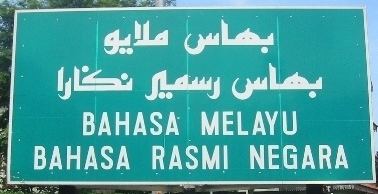 | ||
There are a number of languages spoken in Brunei. The official language of the state of Brunei is Standard Malay, the same Malaccan dialect that is the basis for the standards in Malaysia and Indonesia. This came into force on 29 September 1959, with the signing of Brunei 1959 Constitution.
Contents
- Map of Brunei
- Standard Malay
- Brunei Malay
- English
- Chinese
- Minority languages
- Arabic
- Indian languages
- Nepali languages
- Expatriate languages
- References
Map of Brunei
Standard Malay
The Malay language is the standard language for many of the peoples of Maritime Southeast Asia and is spoken as a lingua franca in Brunei. The official standard for the language, has been defined and agreed upon by the Language and Literature Bureaus of Indonesia, Malaysia and Brunei. Standard Malay is also accepted in the printed form and is used in all official Brunei government media.
Brunei Malay
The local dialect, Melayu Brunei (Brunei Malay), is the most widely spoken language. It is spoken by about 266,000 people. About 84% of its words are cognate with Standard Malay, while 94% are reported to be cognate with Kedayan.
Brunei Malay is also spoken as a lingua franca in some parts of East Malaysia such as the Federal Territory of Labuan, the districts of Limbang and Lawas (Sarawak) and the districts of Sipitang, Beaufort, Kuala Penyu and Papar (Sabah). It is expanding at the expense of the indigenous minority languages.
Although its lexis is 84% cognate with Standard Malay, Brunei Malay is mostly mutually unintelligible with other dialects of Malay.
English
English is widely used as a business and official language and it is spoken by a majority of the population in Brunei. There are two daily English language newspapers, Borneo Bulletin and The Brunei Times, but only one daily newspaper in Malay, Media Permata, which is published six times a week (as there is no Sunday edition).
The bilingual system of education was introduced in 1985, with the first three years taught in Malay while English was the medium of instruction for most subjects from the fourth year of primary school onward, so all school children have had substantial exposure to English since then. In 2008, the new SPN21 education system was introduced, and from then on, maths and science have been taught in English from the start of primary school, so the role of English is even more firmly established.
One result of the promotion of both English and Malay in Brunei is that minority languages, such as Tutong and Dusun, tend to get squeezed out. Noor Azam has described the situation using the Malay proverb: Gajah berperang, pelanduk mati di tengah-tengah. ('When elephants fight, the mouse-deer between them dies.') Some features of the pronunciation of English in Brunei are: the TH sound at the start of words such as thin and think tends to be pronounced as [t]; vowel reduction is mostly avoided in function words such as of and that; and there seems to be an increasing incidence of rhoticity.
Chinese
The Chinese minority in Brunei speak a number of Chinese varieties. The Hokkien (Min Nan) tongue predominates in the Brunei-Muara and Temburong districts, while Cantonese and Hakka speakers are mostly concentrated in the Seria and Kuala Belait areas of the Belait district. Other varieties of Chinese spoken in Brunei include Hoisan, Fuchow and Hainanese.
Mandarin is the language of instruction at the primary level in the private Chinese schools, and is taught as a subject at the secondary level. Mandarin is also used as the lingua franca among the Chinese community.
Minority languages
There are five minority peoples native to Brunei, each with their own language: Tutong, Belait, Dusun, Bisaya, and Lun Bawang ('Murut'). They are less than 40% cognate with Brunei Malay, and are being replaced with it through intermarriage and conversion to Islam.
Iban, Penan, and Melanau are spoken by immigrants from Sarawak.
Arabic
Arabic is the language of the Quran and is used by Islamic scholars in Brunei. The official religion of Brunei is Islam and as such, all adherents of the faith possess some proficiency in reading and speaking Arabic.
Arabic is taught in schools, particularly religious schools, and also in institutes of higher learning. As of 2004, there are six Arabic schools and one religious teachers' college in Brunei.
Indian languages
The Indian minority in Brunei originates mostly from southern India. They are joined by a relatively large expatriate community, estimated at about 7500, from India. Tamil is mainly spoken by Indians in Brunei.
Nepali languages
There is also a contingent of Nepali soldiers of the Gurkha Reserve Unit in Sungai Akar camp and 1st and 2nd Battalion of the Royal Gurkha Rifles stationed in Seria, Brunei. The language spoken by most of these soldiers is Gurkhali. There are Gurkhali languages services provided by Radio Television Brunei and the British Forces Broadcasting Service.
Expatriate languages
Besides the expatriate Indians, Brunei also has a large expatriate community of Filipino, Indonesian and English-speaking origins.
